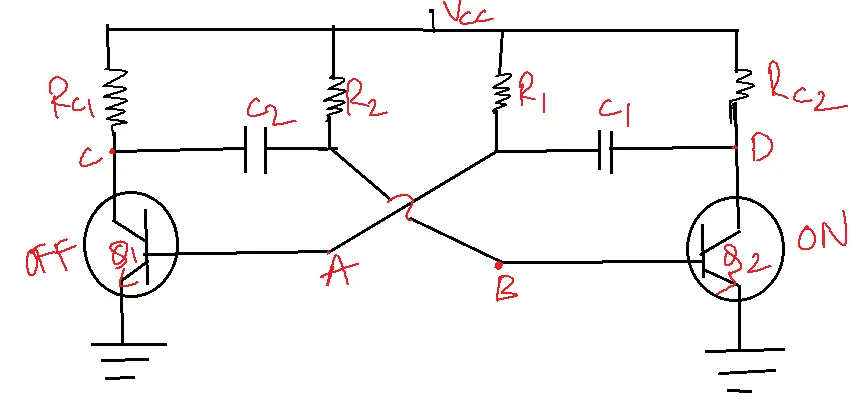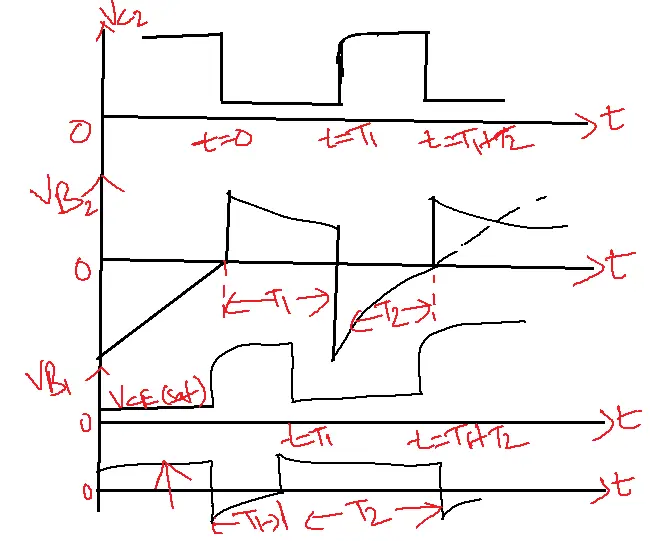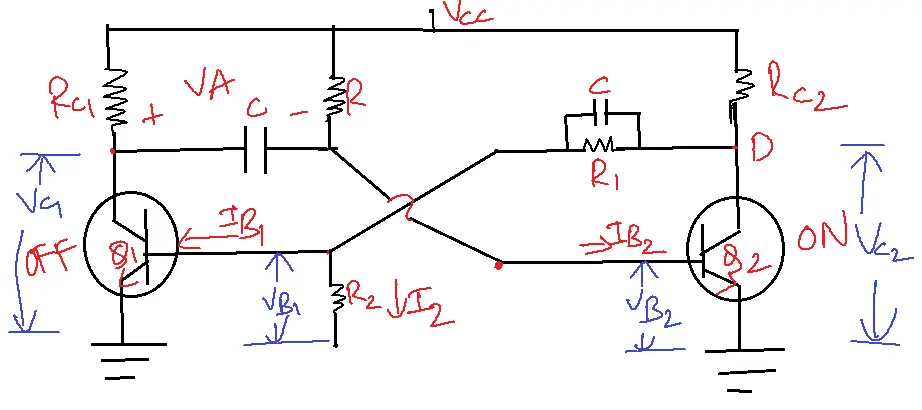An Astable Multivibrator is an electronic oscillator that generates a square wave output without any external trigger. It is a crucial component in digital electronics and is also used in various applications such as clock generation, pulse generation, and frequency division. A monostable Multivibrator is also called a short Multi Vibrator.
MULTIVIBRATORS
Multi means many.
Vibrator means oscillator.
A multivibrator is a circuit that can oscillate at several frequencies.
A multivibrator is an oscillator that can generate non-sinusoidal waveforms.
Stable state
The stable state of a multi-vibrator is the state in which the device can stay permanently, only when a proper external triggering signal is applied to change its state.
Quasi stable state
It is a temporary state.
The device cannot stay permanently in this state. After a predetermined time, the device will automatically come out of a quasi-stable state.
Q1 – ON Q2 – OFF → stable state
Trigger
Q1 – OFF Q2 – ON → quasi-stable state
Table of Contents
Astable Multivibrator
An Astable Multivibrator consists of two transistor switches that alternate between stable states, producing a continuous square wave output. The circuit uses positive feedback to switch between the two states, with no external trigger required.
Collector Coupled Astable Multivibrator

The Astable Multivibrator circuit consists of:
– Two NPN transistors (Q1 and Q2)
– Two resistors (R1 and R2)
– Two capacitors (C1 and C2)
– A power supply (Vcc)
Operation
At t=0, Q2 is ON, Q1 is OFF.
At t=0–(t<0), Q2 is OFF, Q1 is ON.
Q→Q.S
T=1.38RC
2 capacitors [coupling elements]
Astable Multi Vibrator uses AC coupling.
Astable Multi Vibrator doesn’t require any triggering.

Problems
- Determine the frequency of oscillations and output period for an astable multivibrator circuit with capacitor values C1 and C2 equal to 0.2 microfarads (µF) and resistor values R1 and R2 equal to 25 kilohms (KΩ).
Solution: period T = 1.38RC f=1/T →f=145 Hz.
T = 6.9 msec
- For the astable multivibrator if R1=20KΩ, R2=10KΩ, C1=0.02µF, C2=0.015 µF. Find the frequency of oscillations and duty cycle of the output waveform.
Solution: T1=0.276 x 10-3
T2 = 0.1035 x 10-3
f= 2.63 KHz
duty cycle = T1/(T1+T2) x 100 = 72.7%.
Advantages of Astable Multivibrator
1. Simple and Cost-Effective: These multivibrators are easy to design and implement, using minimal components.
2. Stable Square Wave Output: They generate a stable square wave output without external triggers.
3. Wide Frequency Range: These multivibrators can produce a wide range of frequencies.
4. Low Power Consumption: They consume low power, making them suitable for battery-powered devices.
5. High Accuracy: These multivibrators provide high accuracy in frequency generation.
Disadvantages of Astable Multivibrator
1. Sensitivity to Component Values: Output frequency is sensitive to component values, requiring precise selection.
2. Limited Frequency Stability: Frequency stability is limited, affected by temperature, voltage, and component tolerances.
3. No Control Over Duty Cycle: These multivibrators typically have a 50% duty cycle, with no easy control over duty cycle adjustments.
4. Output Amplitude Variation: Output amplitude may vary with frequency, affecting signal integrity.
5. Prone to Noise and Interference: These multivibrators can be susceptible to noise and interference, affecting output stability.
Applications
Astable Multi Vibrator is used as a master oscillator to generate square waves. It is also called a relaxation oscillator or square wave generator. It is a basic source of fast waveforms.
- Clock Signal Generation: It generates clock signals in digital systems, synchronizing components and enabling proper data processing and control.
- LED Flashers and Blinkers: These multivibrators are commonly used in LED flashers and blinkers, creating rhythmic on-off patterns in indicator lights and decorative lighting, due to their simplicity and reliability.
- Frequency Dividers: These multivibrators produce submultiples of input frequencies, serving as clock frequency dividers in digital systems.
- Pulse Generators: In test and measurement applications, these multivibrators are valuable for troubleshooting and analysis due to their ability to generate precise pulses with adjustable frequency and duty cycle.
- Tone Generators: These multivibrators generate audio tones for alarms, sirens, and other audio applications by controlling output frequency.
Monostable Multi Vibrator
A Monostable Multivibrator is an electronic circuit that generates a single pulse of a fixed duration when triggered by an input signal. It is also known as a “one-shot” multivibrator.
Working
1. The circuit has two states: stable and quasi-stable.
2. In the stable state, the output is low (0).
3. When an input trigger is applied, the circuit switches to the quasi-stable state and the output goes high (1).
4. The circuit remains in the quasi-stable state for a fixed duration (determined by the RC time constant).
5. After the fixed duration, the circuit returns to the stable state, and the output goes low (0) again.
Characteristics
– Generates a single pulse of fixed duration
– Triggered by an input signal
– Has two states: stable and quasi-stable
– Output is high for a fixed duration

A monostable Multivibrator is also called a short Multi Vibrator.
When VCC is given Q1 is OFF, Q2 is ON then VC1 = VCC, VB2=VBE(sat) → stable state.
When an external trigger is applied to Q1’s collector, Q2 turns off and Q1 turns on. VC1=VCC-I1RC or VC1=VCE(sat) occurs when Q1 becomes ON. I1 abruptly lowers the collector voltage.
This sudden change in the capacitor acts as a short circuit. So VB2 also falls by the same I1RC amount since Q1 is ON and capacitor C finds a charging path. The capacitor has to charge up to VCC. Here capacitor voltage is nothing but VB2. Whenever VB2 reaches Vgamma Q2-ON, Q1-OFF.
Advantages of Monostable Multivibrator
1. Generates a Single Pulse: Produces a single pulse of fixed duration, useful for timing applications.
2. Simple Design: These multivibrator circuits are relatively simple to design and implement.
3. Low Power Consumption: Observe low power, making them suitable for battery-powered devices.
4. High Accuracy: Provides high accuracy in pulse generation and timing.
5. Wide Range of Applications: Used in various digital circuits, such as pulse generation, frequency division, and digital logic.
Disadvantages of Monostable Multivibrator:
1. Limited Flexibility: Generates a single pulse of fixed duration, limiting flexibility in pulse width adjustment.
2. Sensitivity to Component Values: Output pulse duration is sensitive to component values, requiring precise selection.
3. No Control Over Pulse Width: No easy control over pulse width adjustment.
4. Prone to Noise and Interference: Can be susceptible to noise and interference, affecting output accuracy.
5. Limited Re-triggering Capability: This cannot be re-triggered until the output pulse has ended.
Applications
- Timing and Delay Circuits: These multivibrators generate precise time delays, making them crucial in timing applications like timers, time-delay relays, digital clocks, and counters.
- Pulse Shaping and Regeneration: These multivibrators restore distorted pulses to clean signals in digital systems, aiding data communication and pulse-width modulation.
- Switch Debouncing: Mechanical switches prone to contact bounce can be debounced using these multivibrators for a clean output signal. Essential in digital input circuits for reliable button presses and switch inputs.
- Frequency Dividers: These multivibrators are used as frequency dividers, creating lower-frequency signals or different clock signals for digital systems.
- Triggering and Synchronization: These multivibrators are suitable for triggering and synchronizing events in digital systems, including data acquisition systems and sequential logic circuits.
FAQs
1. What is an astable multivibrator?
- An astable multivibrator is an electronic circuit that produces a continuous square wave output without requiring an external trigger.
- It has no stable states, constantly switching between its two output levels.
2. How does an astable multivibrator work?
- These multivibrators typically use two transistors or other active devices connected in a positive feedback configuration.
- The circuit charges and discharges capacitors, causing the output to switch back and forth between high and low states at a specific frequency.
3. What are the applications of astable multivibrators?
- Astable multivibrators are widely used in various applications, including:
- Clock signal generation: Providing timing signals for digital circuits.
- Square wave generation: Generating square waves for various purposes, such as driving LEDs, controlling motors, and generating audio signals.
- Pulse generation: Producing pulses for timing and triggering other circuits.
4. What is the formula for determining the frequency of an astable multivibrator?
- The frequency of an astable multivibrator depends on the values of the resistors and capacitors in the circuit. Specific formulas exist for various configurations, like the 555 timer-based astable multivibrator.
5. What are the advantages and disadvantages of astable multivibrators?
- Advantages:
- Simple and inexpensive to build
- Can generate a wide range of frequencies
- Versatile applications in various electronic systems
- Disadvantages:
- Output frequency may not be perfectly stable due to component tolerances
- Can generate electromagnetic interference (EMI) due to rapid switching
6. What is a Monostable Multivibrator?
- A monostable multivibrator, also known as a one-shot multivibrator, is a pulse generator circuit that produces a single output pulse of a predetermined duration in response to a triggering input signal.
- It has one stable state and one quasi-stable (temporary) state.
7. How does a Monostable Multivibrator work?
- In its stable state, one transistor is conducting and the other is cut off. When a trigger pulse is applied, it forces the circuit into its quasi-stable state, where the conducting and cut-off states of the transistors are reversed.
- The circuit remains in this quasi-stable state for a fixed period determined by an RC time constant, and then automatically returns to its stable state.
8. What are the applications of a Monostable Multivibrator?
- Timing circuits: Generating precise time delays or time intervals.
- Pulse generation: Producing single pulses of a specific duration.
- Switch debouncing: Eliminating unwanted multiple transitions caused by mechanical switch bounce.
- Pulse width modulation (PWM): Producing signals to regulate motor speed or LED brightness.
- Frequency division: Dividing the frequency of an input signal by a fixed factor.
9. What are the advantages of using a Monostable Multivibrator?
- Simple design: Easy to implement using basic components like transistors, resistors, and capacitors.
- Precise timing: Provides accurate and repeatable time delays.
- Wide range of applications: Used in various timing, control, and pulse generation applications.
10. What are the limitations of a Monostable Multivibrator?
- Limited duty cycle: The maximum duty cycle (ratio of pulse width to period) is typically less than 50%.
- Sensitivity to noise: Triggering can be affected by noise or glitches in the input signal.
- Temperature dependence: The output pulse width can vary with temperature due to changes in component values.
